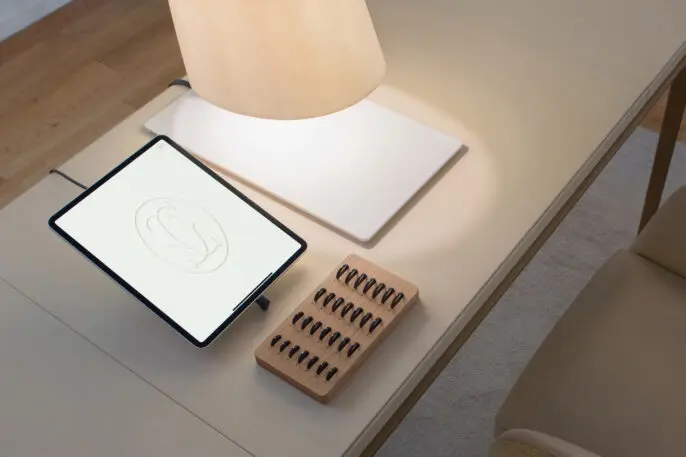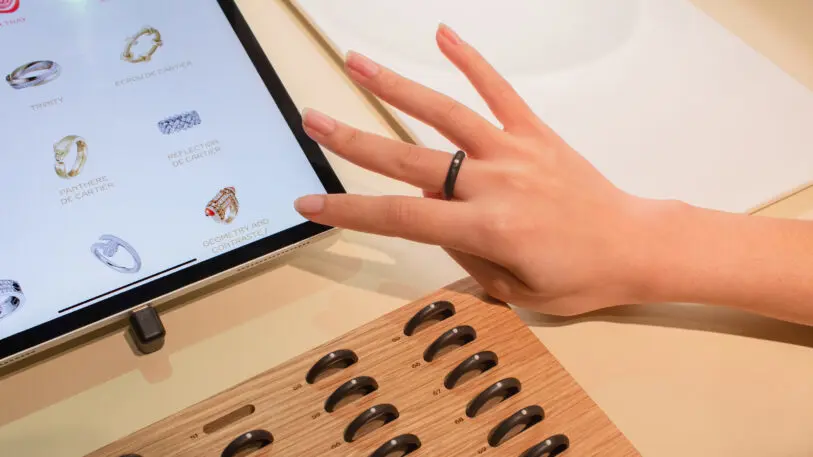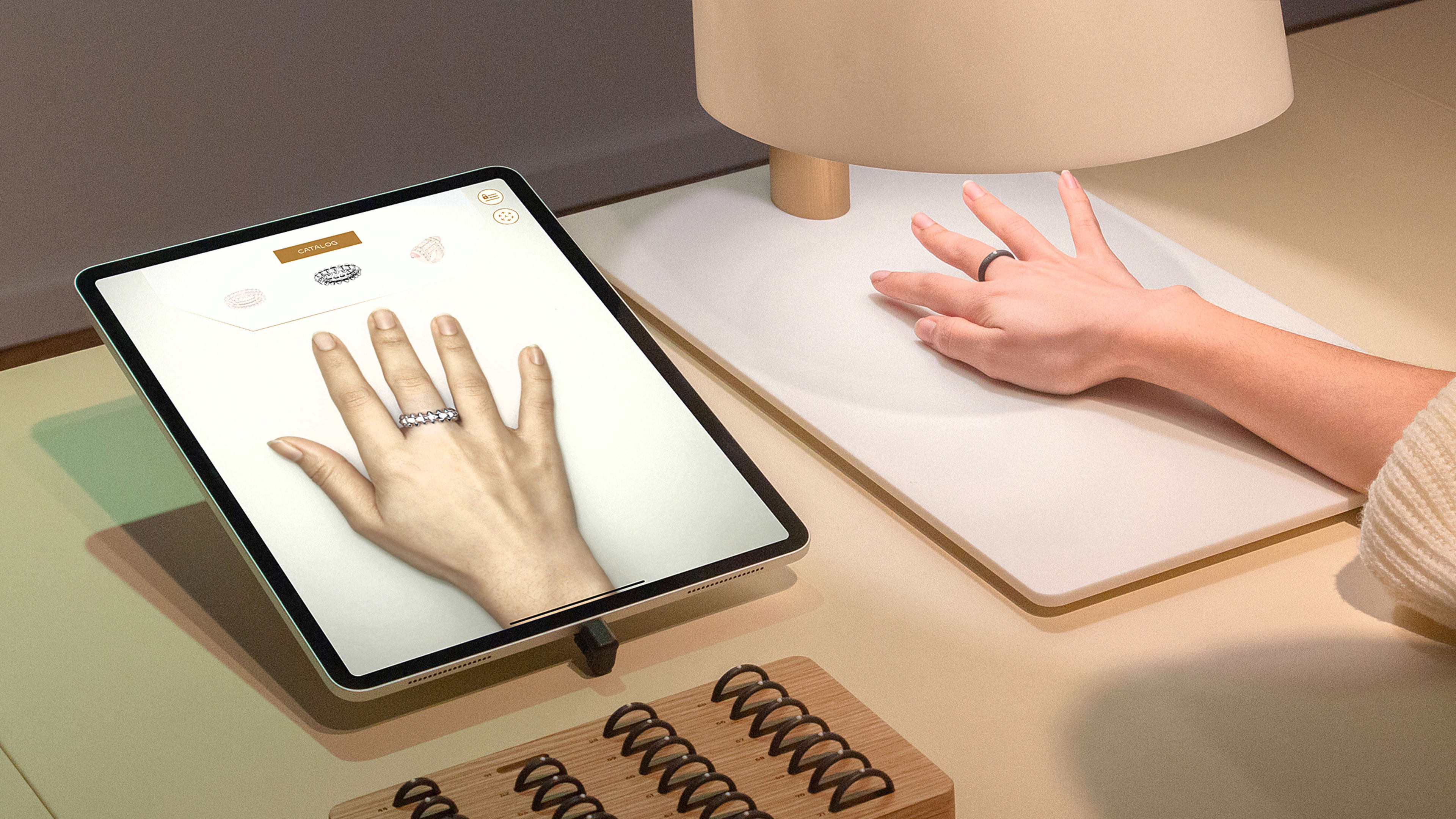I’m wearing Cartier’s iconic Trinity ring: Three 18K white gold bands intertwined around my righthand ring finger, sparkling with 432 brilliant-cut diamonds. The ring doesn’t belong to me—it probably never will—but as I look at my bejeweled hand splayed out under a frosted glass lamp shade at the Cartier Retail Innovation Lab in Brooklyn, I feel like a French socialite whose fingernails could do with a manicure.

Not only do I not own this ring, I’m not even actually wearing it. What I am wearing is a simple, matte black “marker ring” with a tiny raised dot. When I slide my hand under that lamp, which is so much more than a lamp, my hand appears on a tablet right next to me, in crystalline 4K resolution. As I flex my real hand, my iPad hand flexes, too, and the lag between the two is virtually nonexistent. The only difference is that my hand, the real hand, is wearing a dummy ring that’s probably worth $100, while the other is shimmering with $35,000 worth of jewels.

What I’m experiencing is known as virtual try-on technology. The practice has been around for about a decade, but in recent years, technological advancements have led to an explosion of AR try-ons that run the gamut from furniture to eyewear to fashion. But there’s a key difference between those initiatives and the technological feat that Cartier has just pulled off: Unlike most other initiatives, Cartier doesn’t rely on 3D modeling technology, where a 3D model of a ring would awkwardly be superimposed onto your finger. Instead, it uses GAN, or generative adversarial networks, which are most commonly used to make deepfake videos. As the head of Cartier’s Retail Innovation Lab, Andrew Haarsager, explains, “when you have a 3D model that’s being rendered by the phone and it doesn’t know the lighting conditions of your hand, it always kind of looks cartoonish.”
“Cartoonish” isn’t the kind of adjective Cartier is aiming for when wooing prospective customers. “You don’t really realize it, but the way a piece of jewelry looks real is that it’s reflecting the environment around you. You can see the reflection of your other fingers in the ring, you can see the light sources match where the light’s coming from in the room,” he says. So, in 2019, Cartier’s Retail Innovation Lab, which itself had launched two years prior, set out to create its own AR try-on technology specifically for rings (together with software developers Jolibrain and Blue Trail Software).
To achieve the desired level of authenticity—and make sure the system performs equally well on any hand and any skin tone—Cartier trained an AI system on a wide variety of skin tones based on Rihanna’s inclusive makeup brand Fenty, which launched with 40 makeup shades and has since expanded to 50. The team then worked on reducing the latency between the real hand and its digital counterpart to under 15 milliseconds, resulting in an absolutely seamless experience. For now, customers can choose between 13 rings, including the Écrou and Clash ring, with 11 more coming soon.
Here, I should note that there is another key difference between Cartier and competing AR try-on technology, and that is that you can’t just download an app and “try-on” a Trinity ring at home. For now, this is an in-person experience only, and the Cartier team has thought this through, all the way down to the lamp, which looks and works as a lamp but doubles as a stealth 4K camera. At the Lab, I spy at least 20 prototypes of this device huddled on a table. The earliest version, designed purely to test the technology, looks like a plexiglass box with lots of cables and zero bells and whistles; in later versions, I can see the team experimented with scale, proportions and how much of your hand you should see when you place it under the lamp shade. “It needs to not be threatening,” says Haarsager. (The Looking Glass is currently being tested in six boutiques across North America, including Toronto, Las Vegas, and Miami; scaling will depend on the results from a six-month pilot study that ends in April.)

That the system isn’t available at home seems like an obvious shortcoming, but the reasoning makes sense. Cartier’s boutiques, even the more expansive ones, can only hold a fraction of the brand’s stock. “Cartier makes so many different variations of products and so many unique items, so by definition, those can only be in one location at once,” says Haarsager. “If that piece of jewelry happens to be on display in New York, the unique buyer for that might actually exist in Houston but won’t ever see it because they’re not in the same room.”
There’s a pragmatic reason, too: GAN technology is reliant on you wearing the marker ring. That raised white dot on the marker ring acts as a motion capture point to help the system track the ring as you move your fingers. Shipping a marker ring to ever prospective customer would be logistically difficult and expensive.
I found that feeling a ring on my finger—never mind that it wasn’t a real ring—helps with the illusion tremendously. You can fiddle with it, twist it back and forth, and if you keep looking at the iPad (and not your real hand), you may even forget which is which. I tried on various rings ranging from a simple, diamond-encrusted band to the chunkier Clash ring, which comes with many more indentations.
The more complex the ring was, the more glitches I noticed on my iPad hand, like slight details blurring out when I rotated the marker ring around my finger, or imperfections that seem virtually impossible to avoid, like what happens when you play with the loose bolts that make up the Ecrou ring, only to find out there are no actual bolts for you to play with on the marker ring. I didn’t get to try Cartier’s famous Panthère ring, which is so visually complex the team is still improving the technology for it.
Eventually, the hope is that Looking Glass will become an extraordinary sales tool without ever compromising on the stellar retail experience Cartier prides itself on. The results are already promising, says Haarsager. The team declined to share sales figures, but Haarsager notes that the first “digital sale” occurred within three days of opening the first boutique in New Jersey, back in October 2022.
People are already buying furniture and even houses sight unseen. What is a diamond ring, by comparison?
Recognize your brand’s excellence by applying to this year’s Brands That Matter Awards before the early-rate deadline, May 3.
